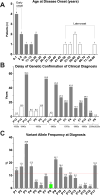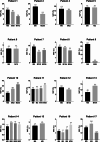Novel Insights into the Clinical Features, Genetic Spectrum and Clonal Evolution of Patients Carrying NLRP3 Mosaicism
- PMID: 41026232
- PMCID: PMC12484329
- DOI: 10.1007/s10875-025-01922-x
Novel Insights into the Clinical Features, Genetic Spectrum and Clonal Evolution of Patients Carrying NLRP3 Mosaicism
Abstract
NLRP3 mosaicism is a well-established mechanism causing the monogenic autoinflammatory disease named cryopyrin-associated periodic syndromes (CAPS). The number of reported patients with NLRP3 mosaicism is small, and the knowledge about the long-term disease behavior is limited. Herein we assembled the largest cohort of individuals with NLRP3 mosaicism reported to date to obtain additional evidence that strengthens the understanding of this disease. The novel genetic data were obtained by using Sanger and next-generation sequencing methods, whereas in vitro analyses determined the functional consequences of detected variants. A total of seventeen individuals with NLRP3 mosaicism were enrolled, with 16/17 experiencing different CAPS phenotypes. An overrepresentation of late-onset forms was detected (37.5%). Overall, clinical manifestations, analytical results, and outcomes of treatments were markedly similar to those detected in patients with germline variants. A large mutational diversity was identified, with 16 different variants among 17 individuals. Two main patterns of mosaicism (extended vs. myeloid-restricted) were detected, with the last one overrepresented in the late-onset group. The evaluation of mosaicism over time identified three different patterns, being the group with stable mosaicism the largest one. Collected evidence supports the marked similarities among patients carrying somatic or germline NLRP3 variants. The overrepresentation of NLRP3 mosaicism in late-onset forms should be considered in patients with inflammatory manifestations starting in adulthood. Analysis of mosaicism at the biological level confirms the two known patterns of corporal distribution and reveals that mosaicism remains stable over time in most patients, but it may also vary during the course of the disease.
Keywords: NLRP3 gene; Autoinflammatory diseases; Inflammasome; Interleukin-1; Interleukin-1 inhibitors; Mosaicism.
© 2025. The Author(s).
Conflict of interest statement
Declarations. Ethics Approval: The Ethical Review Board of Hospital Clínic, Barcelona, Spain approved the study (code HCB/2022/0855). All investigations were performed in accordance with the ethics standards of the 1964 Declaration of Helsinki and its later amendments. Consent to Participate: Written informed consent to participate in this study was obtained from all adult (> 18 years) individual participants or from the parents/legal guardians of those participants under 18 years-old. Consent to Publish: Written informed consent to publish the results of the different performed studies was obtained from all adult (> 18 years) individual participants or from the parents/legal guardians of those participants under 18 years-old. Competing Interests: The authors declare no competing interests. Conflicts of interest: The authors have no relevant financial or non-financial interests to disclose.
Figures





References
-
- Schroder K, Zhou R, Tschopp J. The NLRP3 inflammasome: a sensor for metabolic danger? Science. 2010;327:296–300. - PubMed
-
- Levy R, Gerard L, Kuemmerle-Deschner J, Lachmann HJ, Kone-Paut I, Cantarini L, et al. Phenotypic and genotypic characteristics of cryopyrin-associated periodic syndrome: a series of 136 patients from the Eurofever registry. Ann Rheum Dis. 2015;74:2043–9. - PubMed
-
- Agostini L, Martinon F, Burns K, McDermott MF, Hawkins PN, Tschopp J. NALP3 forms an IL-1β-processing inflammasome with increased activity in Muckle-Wells autoinflammatory disorder. Immunity. 2004;20:319–25. - PubMed
MeSH terms
Substances
Grants and funding
LinkOut - more resources
Full Text Sources
Miscellaneous

